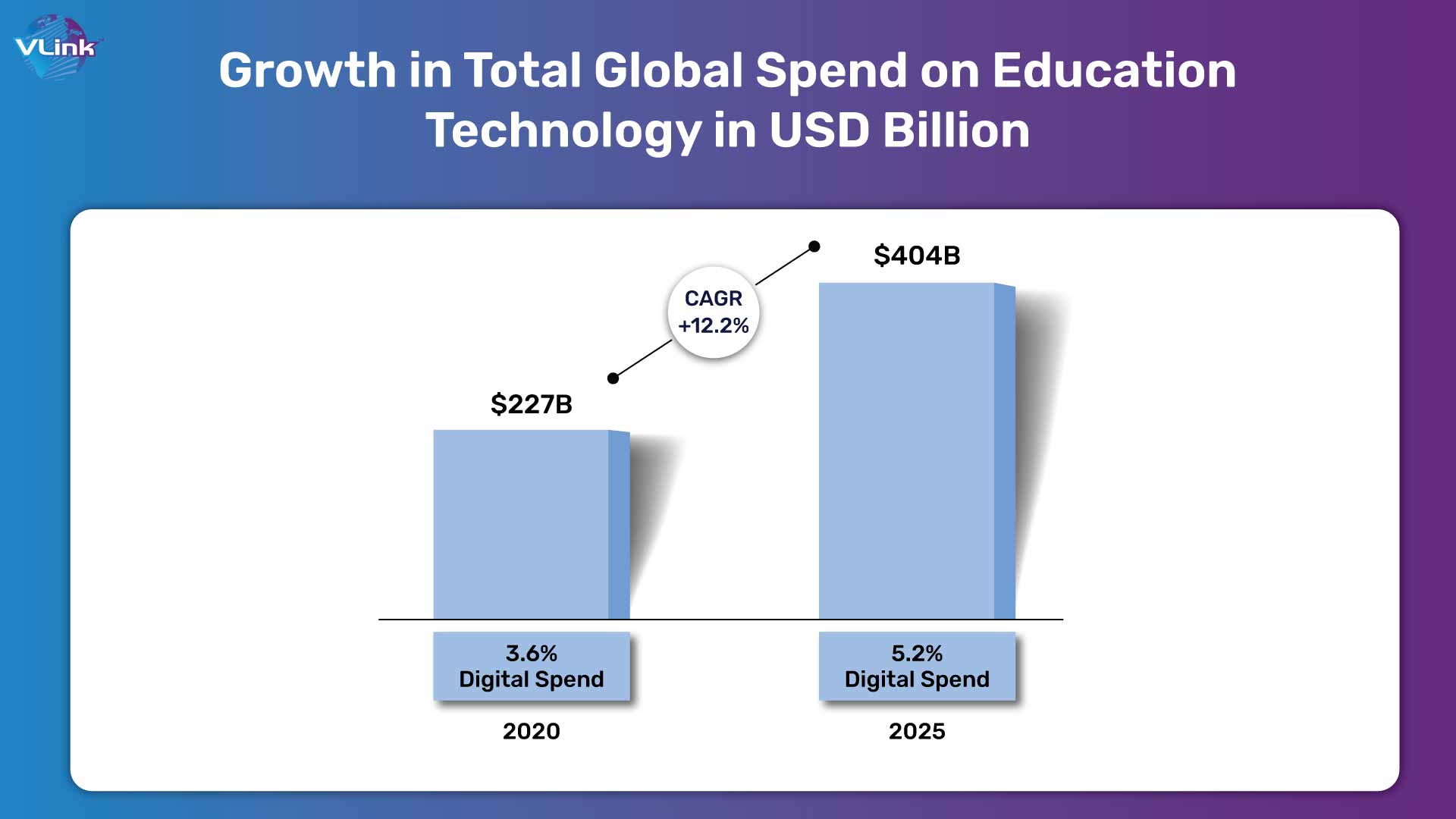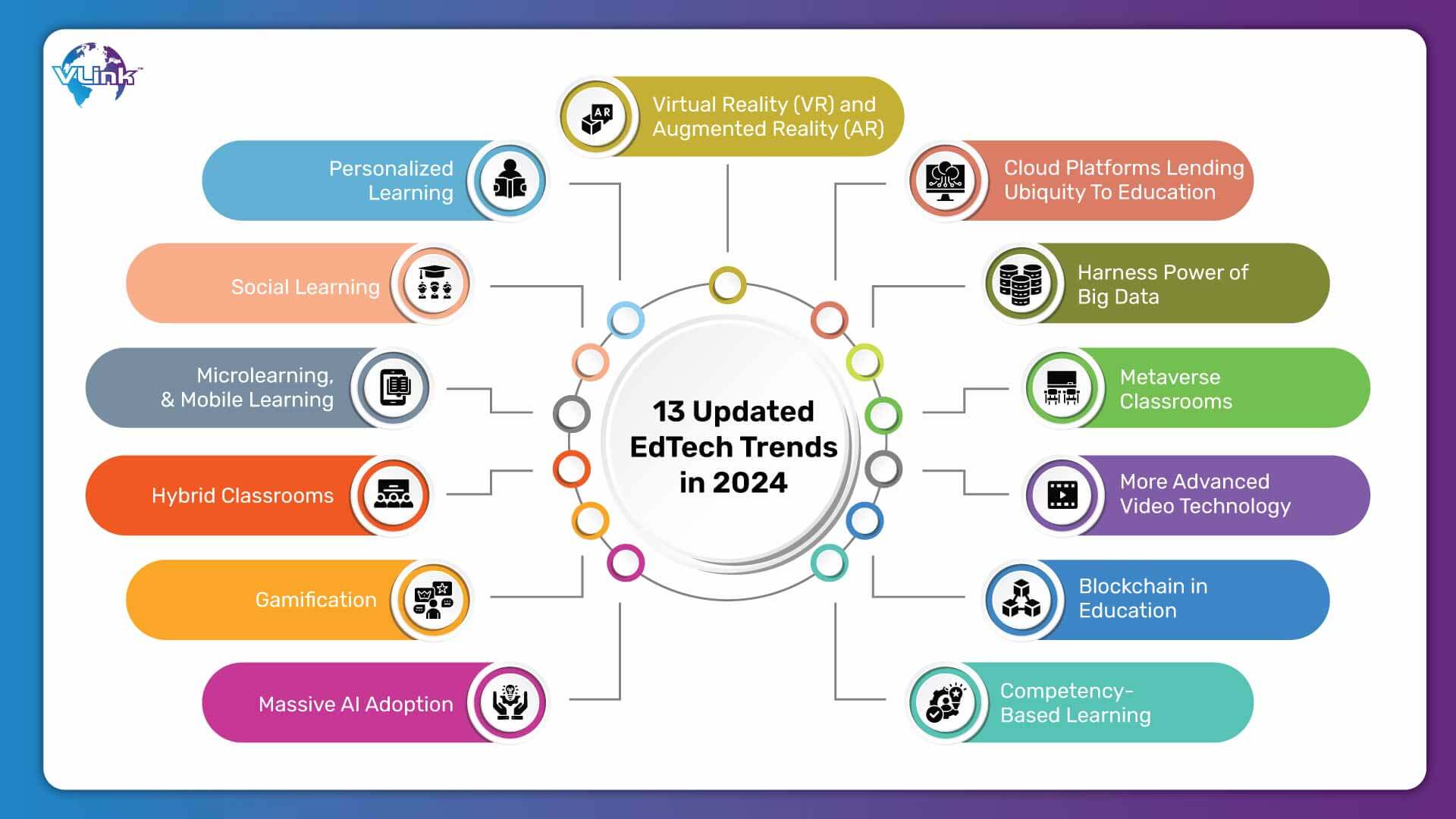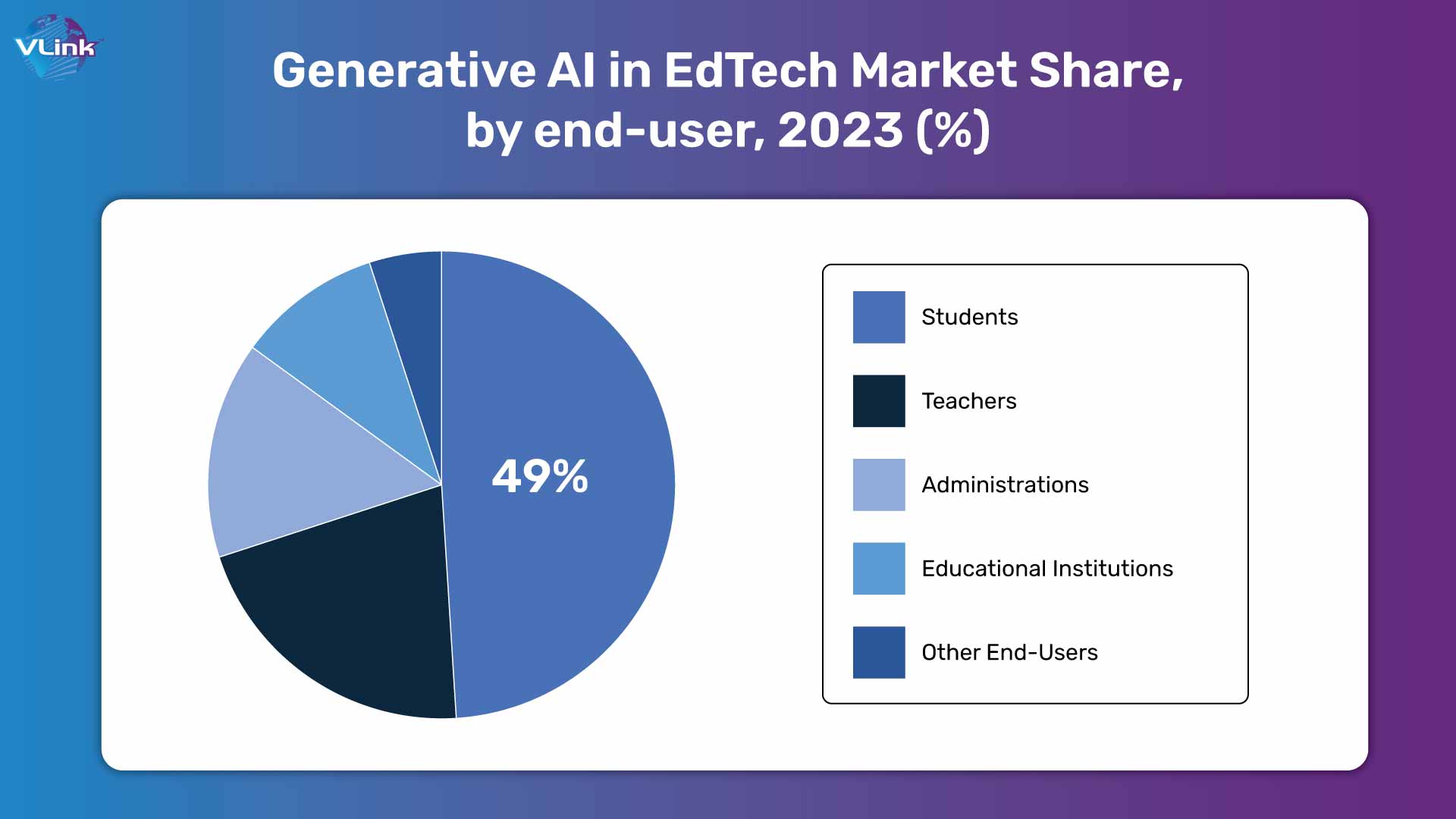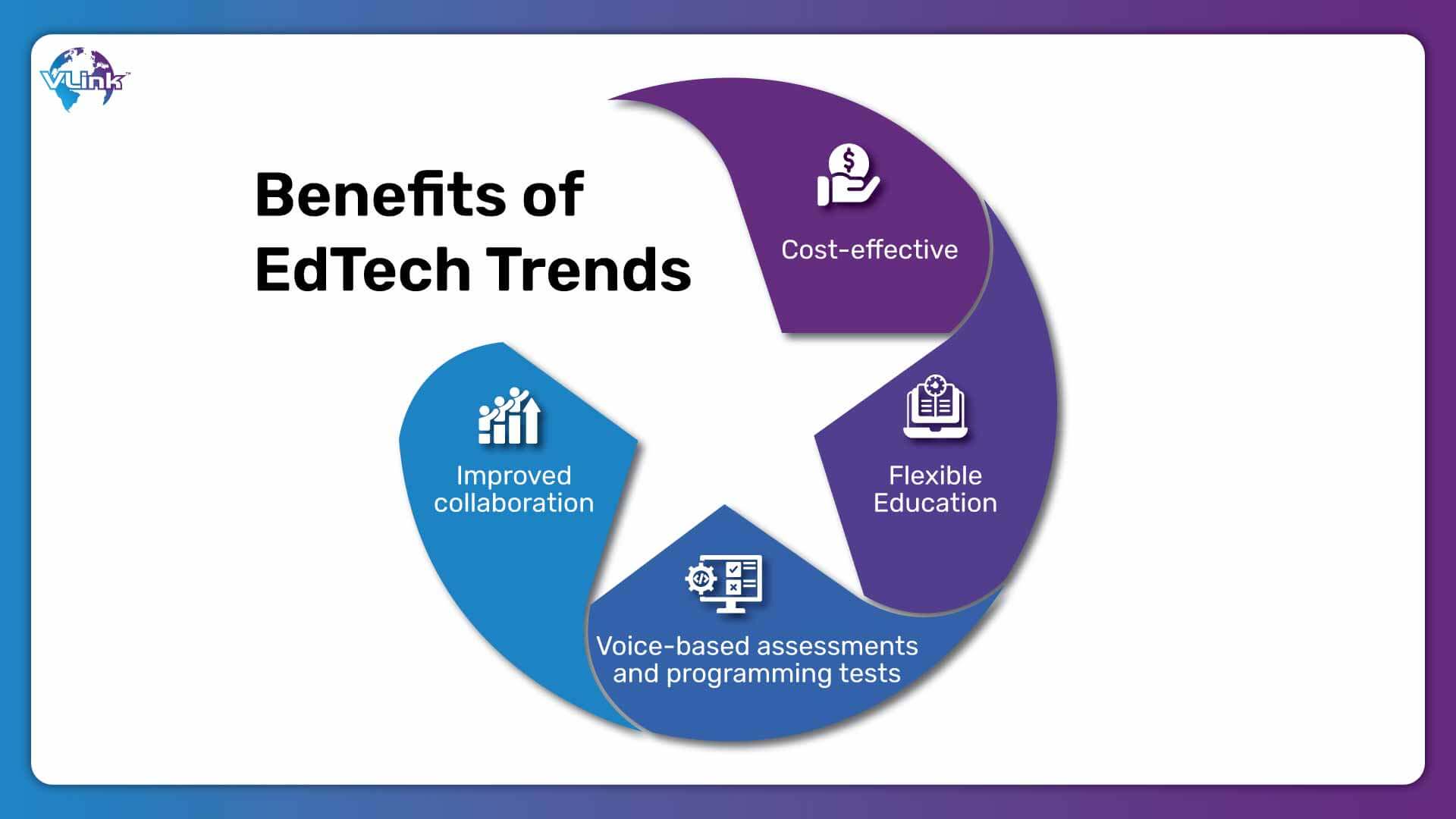Big EdTech companies acquired smaller ones to expand their offerings, while others attracted more funding to incorporate generative AI and wearable technologies in 2023. Undoubtedly, a lot is up on the EdTech trends in 2024 & beyond.
Adaptive learning patterns and personalized learning paths are becoming the updated trend in the education industry. The K-12 Education Technology spending market will hit USD 132.4 billion by 2032 Amid the growing demands for personalized and online learning. EdTech spending is predicted to double in the next 5 years, as shown in the figure below.

So, if you plan to invest in education software development solutions, it's essential to know about updated trends in EdTech. In this blog, we will learn about the 13 most exciting & updated EdTech Trends to watch out for in 2024 & beyond.
What is EdTech?
Edtech, short for education technology, incorporates information and communication technology tools into the classroom setting to improve learning experiences by making them more engaging, inclusive, and tailored to individual needs.
In simpler terms, Edtech aims to enhance or improve the traditional classroom by leveraging digital technology. Many individuals have encountered educational technology through mobile applications.
Numerous companies utilize Learning Management Systems (LMS) like Moodle to organize, deliver, and monitor employee training, and Edtech enables such applications' development.
Amazing EdTech Market Stats for 2024 & Beyond
Here are fantastic Education technology trends stats for 2024 & beyond:
- The global eLearning market is expected to reach US$1 trillion by 2032.
- 90% of companies offer their employees some form of digital learning.
- The EdTech market could reach US$605 billion in value by 2027
- Education apps generated US$7 billion of revenue in 2022, with accelerated growth during the pandemic. Revenue is estimated to grow by a CAGR of 8.9% until 2030.
The Future of Education: 13 Updated EdTech Trends for 2024

Intelligent tutoring systems (ITS) will provide customized learning and feedback to learners to help them master complex knowledge and skills. Powerful and intelligent algorithms adapt to each learner, interpret complex human responses, and adjust 'feedback style' and 'content focus' to align with individual learners' needs.
The transformation is so profound that over 60% of educational platforms are predicted to employ AI-driven learning paths. Adoption of AI in ed-tech to grow at a CAGR of over 47% between 2021 and 2024.

Gamification (incorporating game-like elements like badges, leaderboards, points, and various incentives incorporated into a lesson) will increasingly motivate and encourage learners to achieve a learning objective.
Research has found that these elements make learning fun, attractive, engaging, and immersive, leading to better understanding and retention. Gamification will be a critical element of education, used by every professional E-learning software development company.
The sandbox-style game Minecraft has been used for activities like writing stories, staging performances, and teaching students about DNA. There will be increased adoption of such approaches in the future. Adaptive and intelligent technologies like Augmented Reality (AR) and Virtual Reality (VR) can potentially personalize adult learning experiences.
The global gamification education market is expected to grow substantially, projected to increase from USD 1,146 million in 2024 to USD 5,412 billion by 2029. It represents a CAGR of 36.4% from 2024 to 2029.
If there's one thing the pandemic has made us realize is that we can both distance learning and hybrid learning styles. Both distance and hybrid learning (a mix of in-person and online learning) styles offer more flexibility than traditional schools and learning programs. E-learning development companies will create courses for both distance and hybrid learning programs.
A survey found that 96% of respondents saw improved student engagement via hybrid learning.
It is a widely held belief that students today have shorter attention spans. With shorter attention spans, learners can focus on something taught quickly and absorb information quickly. That's precisely what nano-learning or bite-sized learning does.
Bite-sized information is presented to learners in learning sessions that last two to 10 minutes. Nano-learning will be used to help:
- Educators combat the shortening attention spans of learners
- Learners absorb and retain information quickly and readily.
Another Education trend to look out for in 2024 is Mobile learning or m-learning. It continues to change educational access. With smartphones, tablets, and laptops, learners can study anytime, anywhere, making education borderless.
Here are Mobile Learning Trends for the Education Industry From Reliable Resources:
- One study found 70% of respondents were more motivated to learn when they completed courses on their smartphones.
- By 2027, the worldwide market for mobile learning could reach US$80.1 billion.
- Mobile learning improves productivity by 43%.
- E-learning improves learning retention rates by 25 to 60%.
Social networking platforms like Instagram, Facebook, Twitter, and YouTube have evolved significantly. The Social and Emotional Learning Market size is estimated at USD 9.13 billion in 2024 and is expected to reach USD 9.24 billion by 2029, growing at a CAGR of 0.22%.
They simplify connections, idea sharing, and open discussions. Learning, inherently social and collaborative, embraces the multi-faceted nature of these platforms.
In classrooms, social networks are poised to gain even greater significance. Teachers will leverage them to involve students in learning, share resources, and collaborate on projects.
These platforms can function as virtual bulletin boards and discussion forums, fostering real-time feedback and insights on essential lesson topics.
As we advance into 2024 and beyond, learning approaches will acknowledge students' diverse learning styles and cater to their unique interests, needs, requirements, and aspirations.
Studies indicate that students benefit from personalized instruction outperform 98% of their peers. Educational leaders recognize the importance of delivering tailored experiences in schools, universities, and professional settings.
This customization may involve providing one-on-one educational support for students facing challenges in specific subjects or utilizing software solutions to analyze learner preferences and performance, creating personalized learning paths. Intelligent technology enables real-time monitoring and tracking of each learner's progress, enhancing overall engagement.
In addition, technology-agnostic solutions like cameras and video conferencing software ensure that learners can continue using platforms they are comfortable with, such as Zoom, Microsoft Teams, or YouTube, to access lessons and support.
Both VR and AR enable learners to grasp complex concepts that are hard to explain in the real world but are easily described in detail in a virtual world. The global augmented and virtual reality education market is estimated to register a CAGR of 16.2%, with a valuation of US$ 90 billion by 2033.
They will help students learn better by creating immersive learning experiences in a virtual world or using augmented reality.
We can expect to see more educational institutions using these technologies for education and training to:
- Increase interest in boring subjects like science
- Improve the level of understanding of students
- Explore concepts (for example, chemical reactions) in a safe environment
The coming year will witness a rise in interoperable cloud-based learning material. This will facilitate continued learning through mobile devices, offering learners a wide spectrum of learning resources worldwide.
It will deepen the penetration of online learning. Tapping into the potential of cloud managed infrastructure services can significantly elevate data management, user privacy, and teaching-learning experiences while facilitating information exchange among educators.
Big data analytics services and data science are rapidly becoming leading technologies across industries, and we will see them increasingly used in the education sector.
Big data will be used to help educators:
- Analyze a student's performance based on assignments
- Identify areas where learners struggle or thrive
- Understand the individual learning needs of students
- Develop successful strategies for personalized and customized learning.
A metaverse classroom is a form of educational technology rooted in a shared virtual space linking diverse digital worlds and platforms. Integrating the metaverse with virtual classrooms offers various benefits, creating a dynamic and engaging learning environment.
It's essential to thoroughly assess potential strengths and weaknesses and approach virtual learning design comprehensively.
The sustainability of a metaverse classroom as a long-term solution is subjective. Like other facets of eLearning, its success depends significantly on implementation strategies and the technological tools chosen for utilization.
Video conferencing has become a ubiquitous element of the contemporary classroom, particularly in the era of e-learning. Previously, many video conferencing solutions lacked exclusive designs for educators, prompting schools to adapt standard webcams and microphones with limited functionality.
Zoom, Google Meet, & Team many popular videos conference app available in the market. So, it’s essential to know the cost to build a video conference app like Zoom before investing in this project.
Today, vendors are developing specialized professional PTZ cameras tailored for distance learning and lecture recording. These tools offer advanced live broadcasting and streaming features, enabling educators to engage with hundreds of students in real time.
In addition, these cameras boast enhanced capabilities like auto-tracking technology for capturing crucial information. Teachers can effortlessly annotate their videos and share them with students on E learning platforms like Udemy or Coursera.
Blockchain services has been used successfully to safeguard critical information. We will see a rise in its use in the education sector to safely and securely store massive amounts of student data, digital syllabi, and coursework.
The global blockchain in EdTech market size was USD 118.7 Million in 2021 and is projected to reach USD 3,049.26 Million by 2030, exhibiting a CAGR of 43.94%.
Students will use this technology to store their invaluable diplomas and manage their academic qualifications and achievements. They will be allowed to share these only when they choose and with whom they choose, ensuring complete security.
According to LinkedIn's 2023 Workplace Learning Report, 50% of skill sets are anticipated to change by 2027, emphasizing the importance of lifelong education and the necessity for continuous upskilling. Business owners, employees, and adults prioritize hybrid learning models without time or location constraints.
Competency-based learning, a prevailing EdTech trend, offers flexibility through online modules and self-paced activities. It centers on mastering skills relevant to specific careers or roles, catering to adult learners seeking immediate value.
This approach addresses skill gaps and facilitates job transitions or career advancement, aligning with the principle of lifelong education, where continuous improvement is a constant endeavour.
In 2024, emerging trends in competency-based learning may include:
- Utilizing data to fine-tune learning requirements for competency-based models
- Integrating principles of neuro-education to enhance competency-based learning strategies
- Seeing an increase in performance-based assessments, peer-to-peer collaboration, and micro-learning through quizzes and videos
What are the Benefits of EdTech Trends in 2024?

1. Cost-effective
Online learning will also demonstrate cost-effectiveness by eliminating infrastructure investment. For instance, a candidate enrolls in a full-time offline MBA course, requiring a payment of 50,000 USD. The same course can be reduced to as low as 10,000 USD or 15,000 USD online.
Guest lecturers must travel to the college or university to share their knowledge with eager young minds, contributing to cost savings. Technology, therefore, is poised to prevent you from incurring excessive expenses.
2. Flexible Education
Hybrid education will limit the on-campus presence of students for in-person classes, enabling the management to accommodate more students in each class. This approach eliminates obstacles associated with physical classes, allowing education to become more flexible through technology integration.
3. Voice-Based Assessments and Programming Tests
Education technology benefits the education industry through examples like voice-based assessments and programming tests. Both evaluations can be administered online with education technology.
In voice-based assessments, candidates can verbally articulate their answers, which can be recorded. In programming tests, candidates can write code, and options are provided to compile and run the code, allowing for checking the output.
4. Improved collaboration
Cloud-enabled tools and tablets are facilitating collaboration in the classroom. Loaded with educational games and online lessons, tablets allow children to collaborate on problem-solving.
Additionally, cloud-based applications allow students to submit their homework digitally and engage in online discussions with peers to share their thought processes and seek assistance when needed.
Final Thoughts!
EdTech has advanced significantly and is still expanding. Without a doubt, 2023 and beyond will bring about a significant increase in innovation. The use of technology in the classroom will be instructional sound thanks to EdTech professional software development for teachers. Undoubtedly, great things are happening in E-learning software development, and there is much to look forward to in 2024.
Build a Scalable & Reliable Educational Platform with VLink!
Whether to build, enhance, or re-engineer EdTech tools, VLink's dedicated team are here to help. Our EdTech software development solutions include custom E-learning software development, cloud services, hassle-free AR, VR, 3D imaging integration, and more.
As an e-learning app development company, we help startups, educational institutions, and enterprises build next-generation software leveraging web, mobile, cloud, IoT, product design, and analytics technologies. Our experts have many years of experience, making the learning process globally accessible, interactive, and affordable.
Frequently Asked Questions
The cost to build an educational app or platform varies based on features, complexity, and development time. An essential app may cost US$20,000 to US$50,000, while more advanced platforms can range from US$50,000 to US$150,000. Customization, additional features, and ongoing maintenance also influence the overall cost.
To build an online learning platform like Udemy, follow these steps: Define your niche and target audience, choose a business model, create user-friendly interfaces, integrate essential features (course creation, payment gateways), implement a robust content delivery system, prioritize mobile responsiveness, and focus on marketing and user engagement to attract both instructors and learners.
Technology is pivotal in the education industry by enhancing accessibility, facilitating personalized learning, enabling collaboration, and providing tools for efficient teaching and assessment. It opens new possibilities for remote learning and adaptive learning experiences and fosters innovation, preparing students for the demands of the digital age.
Popular education apps often include platforms like Khan Academy, Duolingo, Quizlet, Coursera, and edX. Keep in mind that the popularity of apps can change over time, so it's advisable to check the latest reviews and rankings for the most current information.








